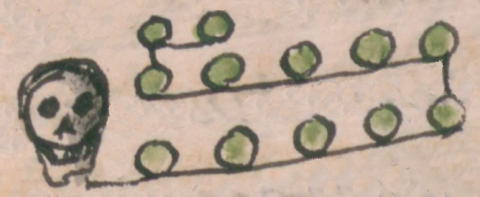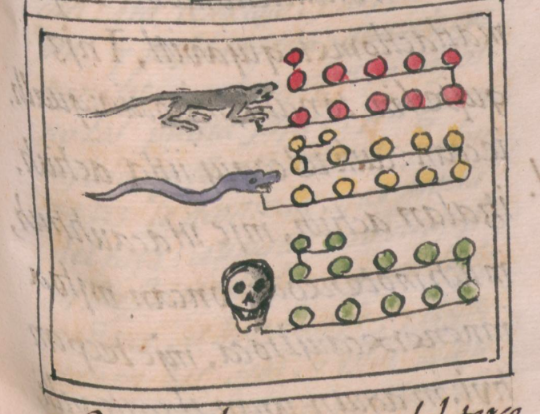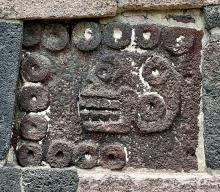Matlactli Omome Miquiztli (FCbk4f7r)
This colorful painting of a simplex glyph-plus-notation has as its focus the date Matlactli Omome Miquiztli ("Twelve Death," or 12-Death), in the religious divinatory calendar called the tonalpohualli. The glyph is a frontal view of a skull, white with some gray shading (showing European stylistic influences). To the right of the skull the notation shows twelve (matlactli omome) small circles connected by lines. These circles (two rows of five and a row of two, as though counted on fingers) are painted green.
Stephanie Wood
1577
Jeff Haskett-Wood
tonalpohualli, fechas, calendarios, días, muerte, calavera, calaveras, numbers, números, mahtlactli, nombres de días
This example of a carved stone hieroglyph representing the date Matlactli Omei Miquiztli (Thirteen Death, or 13-Death) is one number off from the example of the hieroglyph from the Florentine Codex above, but it provides an interesting comparison. One difference is that the skull in the manuscript appears in a frontal view, whereas the carving (older) appears in a profile view. Nevertheless, the museum at Tlatelolco has a display of skulls that seem to have come from a skull rack, and the patterns of the large holes on the sides of the crania suggest that they were displayed in a frontal view, whereby the post when horizontally through the skulls and they were facing forward. This stone carving is located on the Templo Calendárico at the Tlatelolco archaeological site. Photo by R. Haskett, 2 May 2025.

matlactli omei, thirteen, https://nahuatl.wired-humanities.org/content/matlactli-omei
miquiz(tli), death, https://nahuatl.wired-humanities.org/content/miquiztli
Trece Muerte, o 13-Muerte
Stephanie Wood
Library of Congress, https://www.loc.gov/resource/gdcwdl.wdl_10615/?sp=15&st=image
The Library of Congress is unaware of any copyright or other restrictions in the World Digital Library Collection. Absent any such restrictions, these materials are free to use and reuse. Researchers are encouraged to review the source information attached to each item. If you do publish anything from this database, please cite the Visual Lexicon of Aztec Hieroglyphs.




